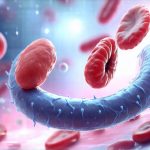Iron deficiency is a global health concern affecting billions worldwide, with anemia being its most common manifestation. While dietary iron intake is crucial, it doesn’t fully explain why some individuals struggle with low iron levels despite adequate consumption. Increasingly, research points to the intricate relationship between our gut microbiota – the vast community of microorganisms residing in our digestive tract – and how effectively we absorb this essential mineral. Understanding this connection isn’t simply about supplementing with probiotics; it’s about cultivating a thriving internal ecosystem that supports optimal iron status and overall well-being.
The traditional view of iron absorption focused heavily on host factors, like the efficiency of intestinal cells and the presence of hepcidin (a hormone regulating iron release). However, this perspective has evolved to acknowledge the significant influence of the gut microbiome. This isn’t a one-way street; iron itself can also impact the composition of the gut microbiota, creating a complex feedback loop. A healthy and diverse gut microbiome plays multiple roles in optimizing iron absorption, modulating inflammation that hinders uptake, and even directly influencing the availability of iron within the digestive system. Ultimately, nurturing this microbial community is proving to be a powerful strategy for preventing anemia and combating the pervasive fatigue associated with iron deficiency.
The Gut Microbiota’s Role In Iron Absorption
The process of iron absorption isn’t straightforward. Dietary iron exists in two main forms: heme iron (found in animal products) and non-heme iron (found in plant-based foods). Heme iron is absorbed more readily, but the majority of dietary iron comes from non-heme sources which are significantly affected by gut health. Several microbial species directly influence how well we absorb non-heme iron. For example, certain bacteria can reduce ferric iron (Fe3+) – a less soluble form – to ferrous iron (Fe2+), which is more easily absorbed by intestinal cells. Conversely, others may promote the oxidation of Fe2+ back to Fe3+, hindering absorption.
The gut microbiome also affects duodenal cytochrome b (Dcytb), a key enzyme involved in absorbing heme iron. Some bacterial metabolites can increase Dcytb expression, thereby enhancing heme iron uptake. Furthermore, the gut microbiota impacts inflammation within the digestive tract. Chronic inflammation, often driven by an imbalanced gut microbiome (dysbiosis), increases hepcidin levels. As mentioned earlier, hepcidin blocks iron absorption and release from storage, exacerbating deficiency. A diverse and balanced microbial community helps maintain gut barrier integrity, reducing systemic inflammation and supporting efficient iron homeostasis. Understanding gut inflammation is crucial for absorption.
Beyond direct effects on iron transport, the microbiota influences the bioavailability of iron. This refers to the amount of iron actually available for absorption after digestion. Certain bacterial metabolites can chelate iron – essentially binding it and making it less accessible for uptake. Others produce compounds that release iron from food matrices, increasing its bioavailability. The composition of your gut microbiome, therefore, determines how much usable iron you extract from each meal. This is why two people eating the same diet might experience vastly different iron status based on their unique microbial profiles.
Microbial Modulation Of Inflammation And Hepcidin
Inflammation is a major antagonist to efficient iron absorption. As noted previously, even mild chronic inflammation triggers increased hepcidin production. The gut microbiome plays a pivotal role in modulating this inflammatory response. A dysbiotic gut – characterized by reduced diversity and an overgrowth of certain bacterial species – often leads to “leaky gut,” where the intestinal barrier becomes compromised. This allows bacterial products (like lipopolysaccharide or LPS) to enter the bloodstream, activating the immune system and triggering inflammation.
Specific microbial strains have been identified as potent anti-inflammatory agents. For example, Faecalibacterium prausnitzii is a key butyrate producer, and butyrate has well-documented anti-inflammatory properties within the gut. Similarly, certain Bifidobacterium species can strengthen the gut barrier and reduce inflammation. Strategies to improve microbial balance – like consuming prebiotic fibers that nourish beneficial bacteria – can therefore significantly reduce intestinal inflammation and lower hepcidin levels, promoting better iron absorption. The role of gut microbiota in regulating inflammation is significant.
The link between the microbiome, inflammation, and hepcidin is bidirectional. Iron deficiency itself can alter the composition of the gut microbiota, often leading to dysbiosis and further exacerbating inflammation. This creates a vicious cycle where low iron fuels microbial imbalances that worsen iron status. Breaking this cycle requires a holistic approach focused on both dietary iron intake and fostering a healthy gut microbiome. Considering gut-brain axis can also help understand inflammatory responses.
Prebiotics, Probiotics, And Dietary Strategies
While probiotics (live microorganisms) have gained popularity, the evidence for their direct impact on iron absorption is still evolving. Some studies suggest that specific probiotic strains can enhance iron uptake or reduce inflammation, but results are often strain-specific and vary between individuals. A more robust strategy often involves focusing on prebiotics – non-digestible fibers that nourish beneficial gut bacteria. Foods rich in prebiotic fiber include:
- Onions
- Garlic
- Leeks
- Asparagus
- Bananas (slightly green)
- Oats
- Apples
These fibers selectively feed beneficial microbes, promoting their growth and activity. This leads to increased production of short-chain fatty acids (SCFAs), like butyrate, which as previously mentioned have anti-inflammatory effects and can improve gut barrier function. Understanding gut movement is also helpful for overall digestion.
Dietary strategies beyond prebiotics are also crucial. Combining iron-rich foods with vitamin C enhances non-heme iron absorption. Avoiding excessive consumption of phytates (found in legumes and grains) and tannins (found in tea and coffee) – which inhibit iron absorption – during meals is also beneficial. Furthermore, a diet rich in diverse plant-based foods provides the varied fibers needed to support a diverse gut microbiome. Prioritizing whole, unprocessed foods is arguably the most effective dietary strategy for long-term gut health and optimal iron status. The role of fasting can also improve digestive balance.
Anemia, Fatigue And The Gut-Iron Connection
Anemia, characterized by a deficiency of red blood cells or hemoglobin, directly impacts oxygen delivery to tissues throughout the body, leading to fatigue, weakness, shortness of breath, and impaired cognitive function. Iron deficiency anemia is the most common type, but other factors like vitamin B12 or folate deficiencies can also contribute. The gut microbiome’s influence extends beyond iron absorption to impact these alternative pathways as well.
Chronic inflammation associated with dysbiosis can disrupt red blood cell production and lead to anemia of chronic disease (ACD), even without severe iron deficiency. The microbiota affects the production of erythropoietin, a hormone that stimulates red blood cell formation. An imbalanced gut microbiome can impair this process, leading to reduced erythropoietin levels and contributing to anemia. Furthermore, the gut microbiome influences the absorption of vitamin B12, which is essential for red blood cell development.
Fatigue, even in the absence of diagnosed anemia, is a common complaint often linked to suboptimal iron status. The relationship between the gut microbiota, iron absorption, and fatigue is complex. Impaired iron absorption leads to reduced energy production at the cellular level, contributing to feelings of tiredness and lethargy. Chronic inflammation, driven by dysbiosis, also contributes to fatigue by disrupting mitochondrial function – the powerhouses of our cells. Addressing both iron deficiency and gut health is crucial for effectively combating persistent fatigue. It’s important to understand the role of gut pH in overall digestive function as well.
It’s important to remember that self-treating anemia or iron deficiency can be dangerous. This information is intended for educational purposes only and should not be considered medical advice. If you suspect you have iron deficiency anemia, consult with a healthcare professional for proper diagnosis and treatment.


















